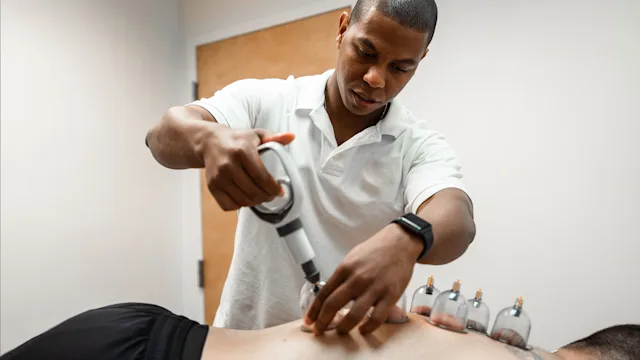Key takeaways:
Ice baths may reduce inflammation, boost mood, or relieve pain after a workout. But there's a need for more research on the benefits of ice baths
There's no official recommendation for how to take an ice bath. But people usually spend 5 to 10 minutes in water that's 50°F to 59°F.
Icy, cold plunges can pose a risk to people with certain conditions, such as peripheral artery disease. Talk to a healthcare professional before you try ice baths.
You might have seen professional athletes jump into an ice bath after a game. Or maybe you know a fitness buff who swears by ice baths for post-workout recovery. Ice-cold plunges are a form of cryotherapy, which involves using cold to treat various health concerns. And ice plunges are favored among many celebrities, with everyone from football players to singers taking a dip.
Although the practice has become popular in recent years, it's nothing new. People have used cold-water immersion for better health and wellness for centuries. Fans of the technique claim it can soothe sore muscles, reduce inflammation, and promote better sleep. However, much of the research on the benefits of ice baths is mixed.
What are the benefits of ice baths?
Ice baths aren't as extreme as whole-body cryotherapy, which involves exposure to very low temperatures. Instead, ice baths require a brief –– usually around 5 to 10 minutes –– plunge in 50°F to 59°F water. Ice bath fans use the practice to remedy muscle soreness, stress, and more.
Search and compare options
Find out what the science says about the following purported health benefits of ice baths.
1. Reduces inflammation and swelling
When you take an ice bath, the cold temperature narrows your blood vessels. This decreases blood flow to your muscles, which may reduce inflammation and swelling. Some research suggests that cold therapy may lower post-exercise inflammation better than compression garments (like compression socks).
2. Relieves sore muscles
Stepping into a cold bath might help relieve sore muscles. Scientists aren't sure exactly how it works. But less inflammation and slower nerve signaling could mean less pain. Cold water could also lower your perception of pain or how much soreness you feel.
According to one systematic review, ice baths may reduce delayed-onset muscle soreness (DOMS) after exercise. But the studies analyzed in the review were low quality. The best way to take an ice bath to soothe sore muscles –– including ideal water temperature, duration, and frequency –– was unclear.
Evidence indicates that ice baths may also ease pain from chronic conditions, including rheumatoid arthritis, gout, and fibromyalgia. But there's a need for more research on ice baths for chronic pain relief and the possible long-term side effects.
3. Aids exercise recovery
When you get out of an ice bath, your blood vessels dilate, or widen, which increases circulation. The nutrient-rich blood flow to your muscles may help remove metabolic waste that builds up during exercise. But research on ice baths as a tool for post-workout recovery is limited and conflicting.
Hot versus cold showers after a workout: Learn the benefits of hot and cold showers to determine which is best for your recovery needs.
How to refuel after exercise: Consider these foods for muscle recovery after your next workout.
Remember to rehydrate: These are 5 of the best post-workout drinks to get the job done.
Some studies suggest that ice baths promote exercise recovery. But it's unclear if the pros outweigh the cons. A 2021 review found that taking an icy cold plunge reduces exercise-induced inflammation. But the researchers noted that ice baths can also hinder training adaptations that allow you to build muscle and improve your performance. However, this potential side effect may only apply to strength training and not aerobic workouts.
One very small study found that ice baths are no more effective than active recovery. So, low-intensity recovery workouts might be a better choice to increase muscle mass or strength.
4. Supports immunity
Some evidence indicates that ice baths support a healthy immune system. In a small study, people were exposed to bacteria to find out how their immune systems would respond. The participants who combined cold-water immersion, deep breathing, and meditation had fewer bacterial infection symptoms than those who didn’t. But it's difficult to conclude how effective cold-water immersion is for your immune system because the study looked at several methods.
Read more like this
Explore these related articles, suggested for readers like you.
5. Improves mental health
Ice baths may be good for your mental health, too. A small study found that taking a 20-minute ice bath every day improved quality of life in people with gout. The study’s participants had better joint mobility and less stress, anxiety, and depression after 4 weeks. Scientists think that exposing your body to cold water triggers a stress response and activates the nervous system. These changes can improve your mood and help you adapt to stress over time.
How do you make an ice bath?
There aren’t standard guidelines for how to make an ice bath. So, most information on the best water temperature, how long to sit in an ice bath, and how often to take one comes from research and firsthand accounts.
You have plenty of options if you decide to try ice baths. You could go to a gym or spa with a cold-water pool or buy an at-home ice bath with a temperature control system. But you can also just use a bathtub. All you need are some ice cubes, a thermometer, and a timer.
To make an ice bath and take a plunge at home:
Fill a tub. Run cold water, fill the tub halfway, and put your thermometer in the tub.
Add ice. Gradually add ice cubes to the water.
Get in. Change into comfortable clothes, like a T-shirt and shorts. Step into the tub slowly when the water reaches 50°F to 59°F (10°C to 15°C).
Set a timer. Set your alarm for 5 to 10 minutes or less, based on what feels right for your body.
Leave the tub. Get out of the tub carefully. Dry off thoroughly before changing into dry clothes.
Some ice bath enthusiasts suggest slowly building up a tolerance to cold-water exposure. For example, it might be a good idea to gradually lower the temperature of your ice baths until you reach a point that works for you. Or you can ease into the icy, cold plunges by starting with lower-body soaks before working your way up to full-body soaks. This way, the icy water isn't as shocking to your system.
How often should you take ice baths?
Many athletes suggest getting in an ice bath as soon as possible after a workout to reduce DOMS. And some research suggests that the method is most effective up to 24 hours after exercise. Other proponents of cold-water therapy recommend ending every shower with a blast of cold water and moving on to regular ice baths only as needed, like when you have muscle aches or pains.
What are the risks of taking ice baths?
Taking ice baths can be risky, especially if you have certain health conditions. So, talk to a healthcare professional before you try ice baths. They may recommend avoiding this practice if you have:
High blood pressure or heart disease
Circulatory problems like peripheral artery disease
Conditions that increase your sensitivity to cold
An open wound
Diabetes
The shock from cold water exposure can stress the heart or even trigger sudden cardiac issues. That's why experts recommend avoiding ice baths if you have a history of heart problems. Other potential risks of ice baths include:
Staying in an ice bath for too long can cause hypothermia, which occurs when your body temperature drops too low. It's important to use a timer and keep your ice baths brief. And remember to pay attention to your body. You should get out of an ice bath immediately if you start shivering uncontrollably or notice changes to your skin color.
Are there alternatives to ice baths for muscle recovery?
Although it's become more popular recently, taking an ice bath is still a controversial method for exercise recovery in some circles. And, in general, there's a need for more high-quality research on the practice.
Fortunately, there are alternatives to ice baths for muscle recovery. Consider these expert-approved methods to soothe sore muscles and promote recovery after exercise:
Cool down after every workout. A 5-minute cooldown with low-intensity cardio and static stretches can kick the exercise recovery process into gear. This type of cooldown helps with gradually lowering your heart rate and relaxing your muscles.
Practice active recovery. Active recovery involves low-intensity exercise after more vigorous workouts. The gentle movement can boost blood flow and relieve muscle pain. Try practicing tai chi, yoga, or swimming on rest days.
Try foam rolling. Foam rolling exercises use targeted pressure to reduce muscle aches and pains. This self-massage technique is a great way to release tight muscles after challenging workouts.
Get a good night's sleep. Adults need 7 to 9 hours of restful sleep every night. This is essential for your health and well-being. And it gives your muscles time to adapt, repair, and grow.
Frequently asked questions
There's no standard guideline for how much ice to use. It depends on several factors, including the size of the tub, water temperature, and your tolerance. For a standard tub, try starting with 15 to 20 pounds of ice, slowly adding ice cubes to a half-full tub of cold water until you reach your desired temperature (between 50°F to 59°F). It might take some trial and error to find the ratio of ice to water that works for you.
It's best to avoid extreme cold or hot temperatures –– from ice baths, saunas, and other practices –– during pregnancy. Anything that changes your body temperature and circulation may affect blood flow to the placenta.
Cryotherapy has been shown to reduce joint pain and swelling from several types of arthritis, including rheumatoid arthritis, gout, and osteoarthritis. So, ice baths may help reduce arthritis symptoms when combined with traditional treatments. But they won't work for everyone. And the benefits may be short-lived. It's best to consult a healthcare professional before taking ice baths for arthritis. They can recommend the best ways to safely manage arthritis symptoms.
Ice baths may have some benefit for the skin. The cold temperature reduces blood flow, which might temporarily reduce swelling or puffiness.
But ice baths can also irritate the skin, especially with prolonged or frequent exposure. This wellness method may cause:
Dryness
Itchiness
Redness
It can also lead to:
Burning
Tingling
Frostnip or frostbite
Consult a dermatologist before using ice baths to address skin concerns.
There's a need for research on how ice baths affect sleep. Current evidence is mixed, and much of it focuses on how ice baths affect sleep after exercise. In one very small study, male endurance runners reported better sleep quality after cold water immersion. In another small study, researchers tested several cryotherapy methods for male runners. They found that whole-body cryotherapy was better than cold-water immersion for exercise recovery and sleep.
There's no standard guideline for how much ice to use. It depends on several factors, including the size of the tub, water temperature, and your tolerance. For a standard tub, try starting with 15 to 20 pounds of ice, slowly adding ice cubes to a half-full tub of cold water until you reach your desired temperature (between 50°F to 59°F). It might take some trial and error to find the ratio of ice to water that works for you.
It's best to avoid extreme cold or hot temperatures –– from ice baths, saunas, and other practices –– during pregnancy. Anything that changes your body temperature and circulation may affect blood flow to the placenta.
Cryotherapy has been shown to reduce joint pain and swelling from several types of arthritis, including rheumatoid arthritis, gout, and osteoarthritis. So, ice baths may help reduce arthritis symptoms when combined with traditional treatments. But they won't work for everyone. And the benefits may be short-lived. It's best to consult a healthcare professional before taking ice baths for arthritis. They can recommend the best ways to safely manage arthritis symptoms.
Ice baths may have some benefit for the skin. The cold temperature reduces blood flow, which might temporarily reduce swelling or puffiness.
But ice baths can also irritate the skin, especially with prolonged or frequent exposure. This wellness method may cause:
Dryness
Itchiness
Redness
It can also lead to:
Burning
Tingling
Frostnip or frostbite
Consult a dermatologist before using ice baths to address skin concerns.
There's a need for research on how ice baths affect sleep. Current evidence is mixed, and much of it focuses on how ice baths affect sleep after exercise. In one very small study, male endurance runners reported better sleep quality after cold water immersion. In another small study, researchers tested several cryotherapy methods for male runners. They found that whole-body cryotherapy was better than cold-water immersion for exercise recovery and sleep.
The bottom line
Ice baths have gained popularity as a workout recovery method. Though ice baths have been shown to relieve muscle aches and pains and may even boost your mood, there are some risks. So, talk to a healthcare professional before taking an icy plunge.

Why trust our experts?



References
Adamczyk, J. G., et al. (2020). Does the type of foam roller influence the recovery rate, thermal response, and DOMS prevention? Public Library of Science One.
Allan, R., et al. (2022). Cold for centuries: A brief history of cryotherapies to improve health, injury, and post-exercise recovery. European Journal of Applied Physiology.
American Academy of Dermatology Association. (n.d.). Welts on skin due to cold temperature could be hives.
American College of Obstetricians and Gynecologists. (2021). Can I use a sauna or hot tub early in pregnancy?
Bleakley, C., et al. (2012). Cold‐water immersion (cryotherapy) for preventing and treating muscle soreness after exercise. Cochrane Database of Systematic Reviews.
Bouzigon, R., et al. (2021). Cryostimulation for post-exercise recovery in athletes: A consensus and position paper. Frontiers in Sports and Active Living.
Centers for Disease Control and Prevention. (2024). Preventing hypothermia.
Chavineau, M., et al. (2021). Effect of the depth of cold water immersion on sleep architecture and recovery among well-trained male endurance runners. Frontiers in Sports and Active Living.
Dupuy, O., et al. (2018). An evidence-based approach for choosing post-exercise recovery techniques to reduce markers of muscle damage, soreness, fatigue, and inflammation: A systematic review with meta-analysis. Frontiers in Physiology.
Garcia, C., et al. (2020). Use of cryotherapy for managing chronic pain: An evidence-based narrative. Pain and Therapy.
Hendricks, S., et al. (2020). Effects of foam rolling on performance and recovery: A systematic review of the literature to guide practitioners on the use of foam rolling. Journal of Bodywork and Movement Therapies.
Herrera, E., et al. (2010). Motor and sensory nerve conduction are affected differently by ice pack, ice massage, and cold water immersion. Physical Therapy.
Ikäheimo, T. M. (2018). Cardiovascular diseases, cold exposure, and exercise. Temperature.
Kelly, J. S., et al. (2021). Improved mood following a single immersion in cold water. Lifestyle Medicine.
Kimura, Y., et al. (1998). The effect of cold stress on uterine artery blood flow velocity waveforms in late pregnant women with and without preeclampsia. The Tohoku Journal of Experimental Medicine.
Kox, M., et al. (2014). Voluntary activation of the sympathetic nervous system and attenuation of the innate immune response in humans. Proceedings of the National Academy of Sciences of the United States of America (PNAS).
Kurniasari, M. D., et al. (2022). Cold water immersion directly and mediated by alleviated pain to promote quality of life in Indonesian with gout arthritis: A community-based randomized controlled trial. Biological Research for Nursing.
Lateef, F. (2010). Post exercise ice water immersion: Is it a form of active recovery? Journal of Emergencies, Trauma, and Shock.
Lunt, H. C., et al. (2010). 'Cross-adaptation': Habituation to short repeated cold-water immersions affects the response to acute hypoxia in humans. The Journal of Physiology.
Malta, E. S., et al. (2021). The effects of regular cold-water immersion use on training-induced changes in strength and endurance performance: A systematic review with meta-analysis. Sports Medicine.
Moore, E., et al. (2022). Impact of cold-water immersion compared with passive recovery following a single bout of strenuous exercise on athletic performance in physically active participants: A systematic review with meta-analysis and meta-regression. Sports Medicine.
Mooventhan, A., et al. (2014). Scientific evidence-based effects of hydrotherapy on various systems of the body. North American Journal of Medical Sciences.
Peake, J. M., et al. (2017). The effects of cold water immersion and active recovery on inflammation and cell stress responses in human skeletal muscle after resistance exercise. The Journal of Physiology.
Petersen, A. C., et al. (2021). Post-exercise cold water immersion effects on physiological adaptations to resistance training and the underlying mechanisms in skeletal muscle: A narrative review. Frontiers in Sports and Active Living.
Qu, C., et al. (2022). Cryotherapy on subjective sleep quality, muscle, and inflammatory response in Chinese middle- and long-distance runners after muscle damage. The Journal of Strength and Conditioning Research.
Roberts, L. A., et al. (2015). Post-exercise cold water immersion attenuates acute anabolic signalling and long-term adaptations in muscle to strength training. The Journal of Physiology.
Srámek, P., et al. (2000). Human physiological responses to immersion into water of different temperatures. European Journal of Applied Physiology.
Stanley, J., et al. (2012). The effect of post-exercise hydrotherapy on subsequent exercise performance and heart rate variability. European Journal of Applied Physiology.
Stull, K. (n.d.). The importance of sleep and recovery. National Academy of Sports Medicine.
Wang, Y., et al. (2021). Heat and cold therapy reduce pain in patients with delayed onset muscle soreness: A systematic review and meta-analysis of 32 randomized controlled trials. Physical Therapy in Sport.
Williamson, L. (2022). You're not a polar bear: The plunge into cold water comes with risks. American Heart Association.
Wim Hof Method. (n.d.). Regular ice baths.


















